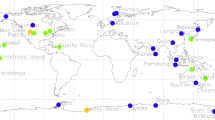Abstract
Radars have been used successfully for many years to measure atmospheric motions over a wide range of altitudes, from ground level up to heights of several hundred kilometres into the ionosphere. In this paper we particularly wish to concentrate on the accuracy of these measurements for winds in the middle atmosphere (i.e. 10–100–km altitude). We begin by briefly reviewing the literature relating to comparisons between radar methods and other techniques. We demonstrate where the radar data are most and least reliable and then, in parallel with a discussion about the basic principles of the method, discuss why these different regimes have the different accuracies and precisions they do. This discussion is used to highlight the strengths and weaknesses of radar methods. Issues like radar volume, aspect sensitivity, gravity wave effects and scatterer intermittency in producing wind biases, and the degree by which the intermittent generation of scatterers at quasi-random points in space could skew the radar measurements, are all considered. We also investigate the possibility that MF radar techniques can be contaminated by E-region scatter to heights as low as 92–95–km altitude (i.e. up to 8–10 km below the ionospheric peak echo). Within all these comments, however, we also recognize that radar methods still represent powerful techniques which have an important future at all levels of the atmosphere.
Similar content being viewed by others
Author information
Authors and Affiliations
About this article
Cite this article
Hocking, W.K. Strengths and limitations of MST radar measurements of middle-atmosphere winds. Annales Geophysicae 15, 1111–1122 (1997). https://doi.org/10.1007/s00585-997-1111-1
Received:
Revised:
Accepted:
Issue Date:
DOI: https://doi.org/10.1007/s00585-997-1111-1




